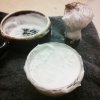- Thread starter
- #41
Kieth, your never too old.I'm interested in following this adventure, but I won't actually be making any soap. Like all creative projects it will require making a lot of bad soap and learning along the way. I'm too old to be looking for another hobby to do badly.



